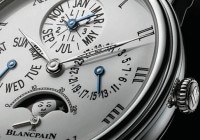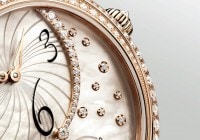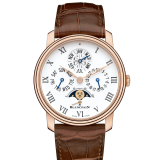
Search in Issues
Chapters
Chapter 7
Villeret Quantième Perpétuel 8 JOURS
An ideal combination: a perpetual calendar and an eight day power reserve.
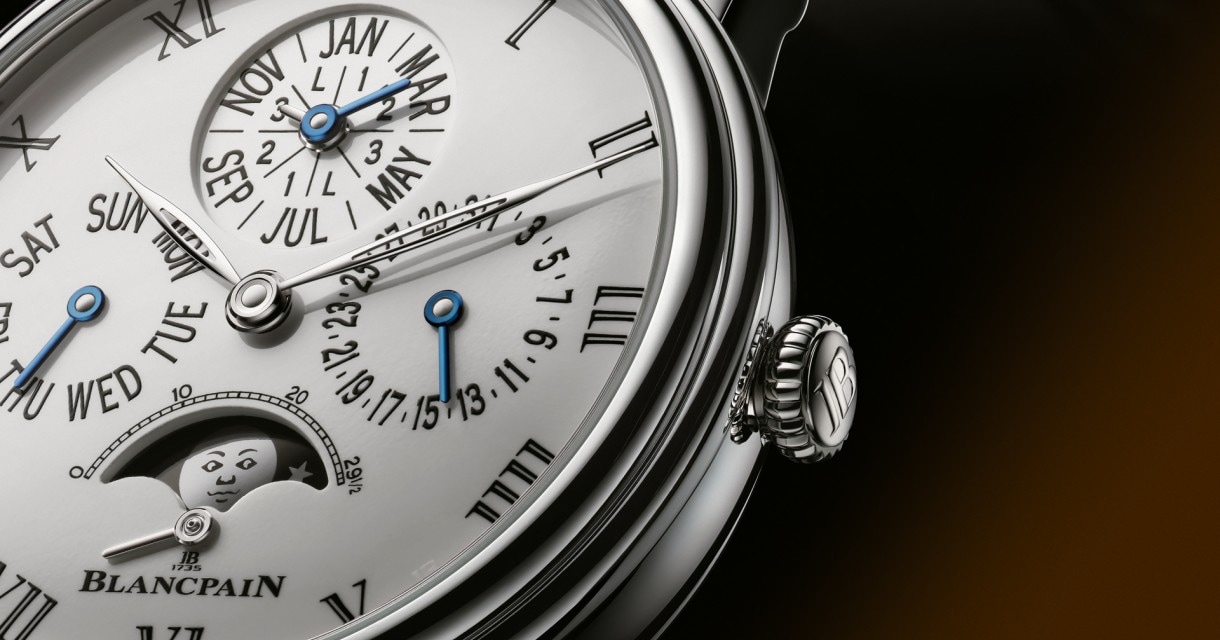
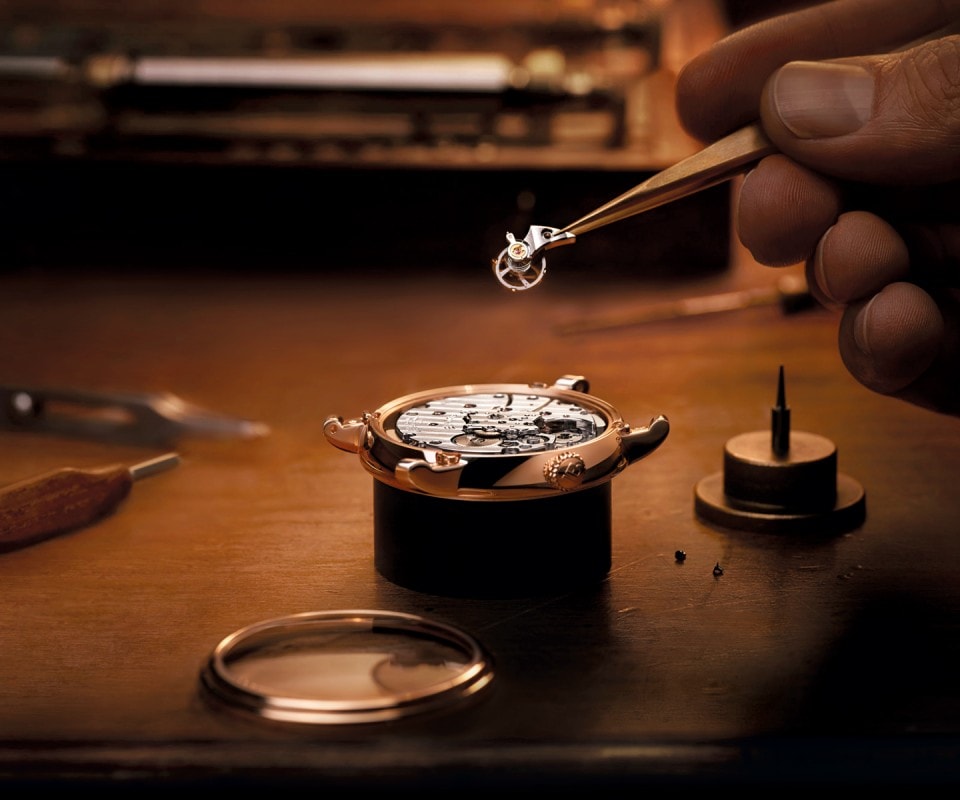
If any complication can be classed as “bread and butter” it would be the perpetual calendar. Thoroughly practical, a perpetual mechanism goesabout its business quietly, discretely. Resolutely laboring, hidden in the background out of sight, its slowly turning wheels and cams dutifully account for the oddities in the four year cycles of the Gregorian calendar. No exciting fireworks. No sparks from spectacular visual displays. Nothing to call attention to itself. Simply the display of the correct date all year long.
But that is the genius of perpetual calendars. Its business-like operation delivers what arguably is the most useful functionality of all watchmaking complications. This utility is amplified even further when the perpetual calendar is paired with a movement that offers an 8 day power reserve. The result: a timepiece capable of running autonomously for more than a week with a complete calendar that always is spot on. That is precisely the calling of Blancpain’s new Villeret Quantième Perpétuel 8 Jours.
Over the last 30 years Blancpain has offered a wide variety of perpetual calendars in its collections, some stand-alone, others paired with additional complications ranging from displays of equation of time, chronographs, split second chronographs, tourbillons and minute repeaters etc. Notwithstanding that long history, the Villeret Quantième Perpétuel 8 Jours’ calendar mechanism is entirely new. Although conceived from a white sheet of paper, it does weave into its complicated mechanism two current pillars of Blancpain’s movement design philosophy: security and hidden correctors.
The concept of security is simple to describe, but difficult to implement. All calendar mechanisms must provide a means for setting all the calendar indications if the movement has been allowed to run down. Industry-wide this has posed a problem of sorts. Standard calendar mechanisms depend upon daily changes of the indications which are effectuated through a geared system. However, if the owner were to attempt manually to set the calendar indications with one of these customary designs while the movement was part way through an automatic change—said another way while the geared system was engaged making the change—it is likely that the delicate mechanism would be broken by the manual intervention. To ameliorate this danger, the customary practice in the industry has been to issue stern warnings in the owner’s manual pointing out, usually in a bold font, the times of the day when it is forbidden to set the calendar manually.
TWO CORE BLANCPAIN DESIGN ELEMENTS are brought to the watch: a secure calendar mechanism and correctors under the lugs.
In Blancpain’s view the owner’s manual warning approach, bold print and all, is an unsatisfactory response. Who wants to fish out a manual every time that a watch requires setting? Instead, why not design the movement in such a way that at all times it is protected from manual setting damage? That is to say, why not make the movement “secure”. This is precisely what Blancpain has done with all of its new calendar mechanisms since it debuted its 66R9 caliber (complete calendar/moon phase) in 2009. The new Villeret perpetual follows this lead with a secured design. The owner is free to actuate any of the correctors, of which there are four (date, day of week, month and moon phase), at any time without risk of damaging the mechanism. This secure design places the new Villeret in rare territory at the head of the class among perpetual calendars found on the market.
The second “core” Blancpain design element brought to the new Villeret perpetual is Blancpain’s exclusive and patented under lug corrector system. The standard means in the watch world by which calendar indications are manually set is via pushers set into the sides of a watch case. With an appearance not unlike a small dimple, this type of corrector requires a tool, in the form of a pin, in order to be used. Naturally, in the same way that the user is required to search for the owner’s manual to know when it is possible to set the calendar, in order, actually, to accomplish the set- ting, a further search is required to find the small pin pusher customarily supplied with the watch, usually nestled somewhere in the presentation box. Blancpain’sunder lug system fully dispenses with any such tool requirement. Replacing dimples on the side of case, together with their associated tool, are small discretely hidden levers tucked underneath in the recesses of the lugs. All that is required is one’s fingertip. All four of the indications are set in mere seconds grasping the watch in one hand and pushing upon each of the four small hidden levers with a finger of the other hand.
And there is an added bonus: removal of all the unsightly dimples that customarily are arrayed on the outer flanks of almost all other perpetual calendars. With the correctors hidden under the lugs, the case sides of the new Villeret are perfectly smooth and unmarred as befits a prestige timepiece with a complicated movement.
Of course, it is the automatic functioning of the perpetual mechanism itself which is central to its allure. Three main components lie at the heart of its operation: 1. A 24 hour wheel whose daily rotation commands the advancement of the date, day of the week, moon phase, and, at the end of the month, the month; 2. The program wheel whose shape takes account of the length of each month over the four year calendar cycle; and 3. The central lever (called “grande bascule”) that co-ordinates the changes of date, day of the week, and, indirectly, the month.

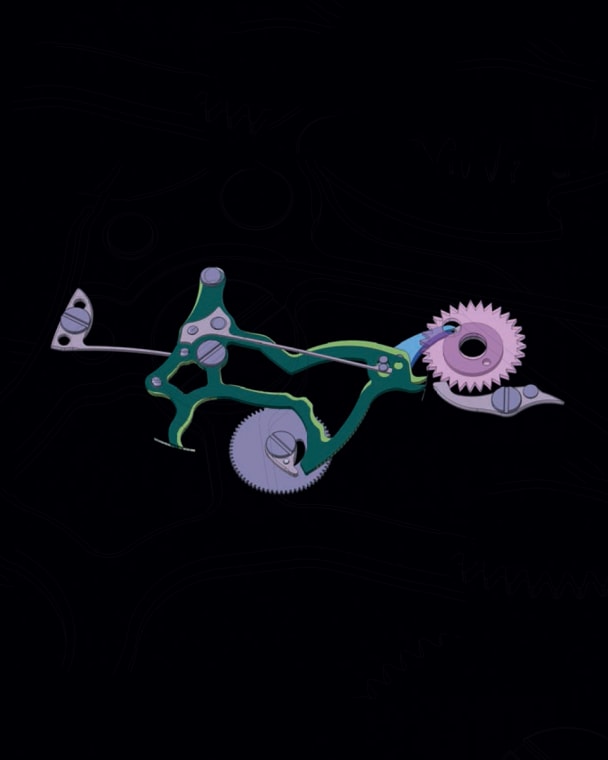
The 24 hour wheel is the most simple to understand. It is the means by which the ordinary daily changes are initiated. The rotation of this wheel carries along with it a cam that comes into contact with a small lever that advances the moon phase disk and a nose on the central lever, one section of which, engages a seven tooth wheel for the day of the week and another section of which engages with a 31 tooth wheel for the date. As the wheel turns once every 24 hours each of these indications goes forward by one day as the cam encounters these two levers.
In the middle of a month, the daily change effectuated by the central lever is easy to understand. As the central lever is pushed by the cam on the 24 hour wheel, the displacement which is caused is just enough to move both the day of the week wheel and the date wheel one tooth each. Obviously, each tooth represents a single day. As must be obvious from this description, seasoned movement savants, gazing at a calendar plate can easily identify these components without aid of further explanation; want to find the day of the week wheel? Look for one with seven teeth. To find the date wheel? Look for one with 31 teeth. And, you saw this coming, for the month 12 teeth.
Things get more interesting at the end of the month. The 31 tooth date wheel carries around with it a cam. Taking the example of a straightforward 31 day month, on that day, as the date wheel is advanced by the grand lever from the 31st to the 1st, its cam engages a 12 tooth gear (you, of course knew that, didn’t you) advancing it by one tooth. That change is transmitted to both the month hand and the program wheel causing each to advance to the next month.
Two positions of the central lever (in green) on the 30th day of the month. For a month of 30 days, the central lever is pushed to a lower position, which causes the finger (in deep blue) to engage the cam located underneath the 31 tooth date wheel (in pink) on the 30th of the month, advancing that wheel to the position of the 1st.
For a month of 31 days, the central lever is positioned higher so that the finger (in blue) does not engage the cam beneath the 31 tooth date wheel on the 30th day of the month. Instead, the finger of the central lever (in green) engages a tooth of the date wheel causing a single day advance from the 30th to the 31st.
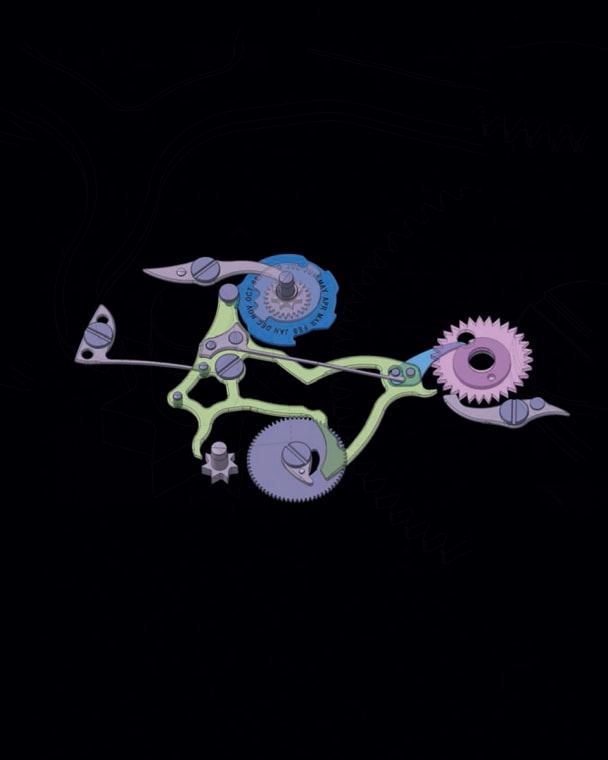
But then, what happens if the month has fewer than 31 days? This is where the design of the program wheel comes into play. Far from smooth, the program wheel has a series of indented areas that correspond months shorter than 31 days. With Blancpain’s design, the program wheel, turning once per year, has carefully calibrated indented areas on its outer edge; said another way, it has “programmed” onto its perimeter the full cycle of the 28, 30 and 31 day months of the calendar. It is the clever design of the grand lever that “translates” those indentations into month and date changes for the short months. There are actually two fingers on the central lever on its portion facing the 31 tooth date wheel. One finger engages the date wheel every 24 hours for the normal one tooth advance of the date. The second finger only becomes engaged when the opposite end of the lever arm comes into contact with one of the indented zones of the program wheel. Positioning is extremely precise as this occurs on the 30th day of the month for those “non-February short months”. When this transpires, this second finger pushes a gear located underneath the 31 tooth wheel to advance it further than the simple one day advance effectuated by the other finger. Thus, instead of advancing only from “30”to“31”,the second finger adds one more advance to “1”. For those months that have 31 days, that is to say, months when the pin on the far end of the grand lever is riding upon a protruding zone of the program wheel, the second finger is pushed to a position where it cannot come into contact with the gear underneath the 31 tooth wheel; thus, in this position there would be only a one day advance of the date wheel to move the hand from “31” to “1”.
A view of the program wheel (in blue) showing its varied shape according to the lengths of the different months of the year. In this view, the month is October and the date wheel (in pink) is in the position of the 31st of the month. The change to the 1st of November will be effectuated by the lower finger of the central lever (in green) which will engage a tooth of the date wheel at midnight.
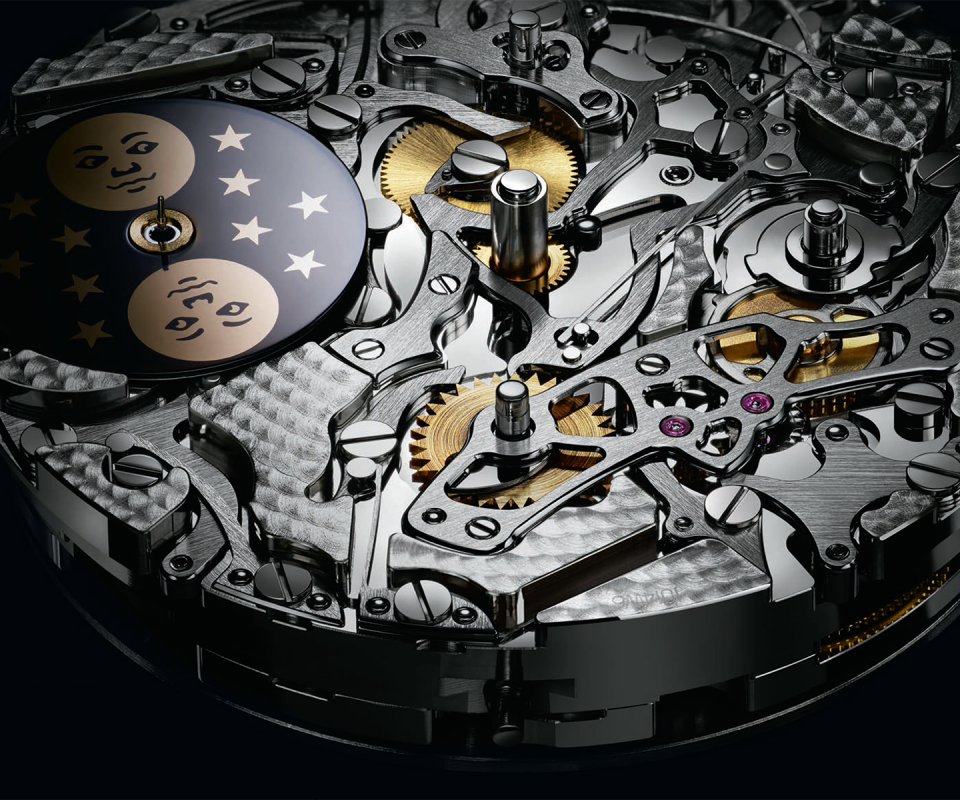
The gleaming finishes of the three key components: the 24 hour wheel (to the right of the moon disk), the central lever running through the center of the movement, and the program wheel to the right of the lever.
Februaries, those vexing months that allow full perpetual calendars to strut their stuff and distinguish themselves from annual calendars that are programmed for the 30 and 31 day months, but not February, are more complicated still. Poised above the program wheel that turns once per year is another disk that accounts for the leap years in the four year calendar cycle. This additional wheel, which turns on an eight year cycle, has two protruding knobs to handle the advance for the leap years (one knob for each of the two leap years that would occur in the eight year rotation). The “normal” 28 day Februaries are accounted for on the program wheel by extra deep indentations. When the pin on the far end of the central lever falls into this extra deep zone, again precisely positioned to occur on “28”, this extra deep penetration causes the second finger to engage not just one tooth, but three teeth on the wheel underneath the 31 day wheel. This causes an advance from “28” to “1”. The two knobs on the eight year disk, change this in two respects. Whereas the pin on the underside of the central lever follows the shape of the one year program wheel, there is another pin on the top side of the central lever that on a leap year encounters the knobs on the eight year wheel. In effect, the knob overrides the program wheel below. When a knob makes contact with the upper level pin, it moves the deep penetration zone forward by one day from the 28th to the 29th and it programs the advance on the 29th to two days.
With three mainspring barrels an EIGHT DAY POWER RESERVE is achieved.
Most perpetual calendars in the industry dispense with all seconds indications and, indeed, several of Blancpain’s previous perpetual calendar models have fallen into this category. With the new Villeret, Blancpain wanted to include the soothing convenience of a seconds indication on the dial. Isn’t it always reassuring to glance at a watch face to see the seconds hand marching around its circle?
To achieve this, two considerations called for cleverness in construction. It was not enough simply to add a small seconds hand. Respect for aesthetics dictated the position. In order to achieve perfect symmetry on the dial, with the placement of the extra-large moon phase display balanced against the subdials for the date, day of week and month and, at the same time, center the small seconds hand onto the moon, the normal position of the axis for small seconds from the base movement needed to be altered. This was accomplished by adding a system of four supplemental wheels on the back side of the movement to effectuate this change of position.
The base movement itself follows the design path which now distinguishes Blancpain’s new calibers. It offers an 8 day power reserve thanks to three main spring barrels. Its balance wheel is fashioned in titanium—a patented invention—with fine regulation accomplished by four heavy gold screws. Screwed fine regulation is far more resistant to shock, than the much more common racket adjustments used by most brands. The balance spiral is made of silicium which offers high resistance to magnetic fields and, together with the carefully engineered three barrel system that evens the spring force as the barrels unwind, endows the watch with steady rate keeping over the full period of the power reserve. The movement plates and bridges boast traditional hand applied côtes de Genève, anglage and perlage finishes. The solid gold automatic winding rotor is decorated with a guilloche pattern.
The Villeret perpetual is housed in a 42 mm platinum or red gold case. The platinum version is limited to but 188 examples. The dial re-enforces the sophistication of the ensemble as it is crafted in full fired bombé enamel with Roman numeral markers.
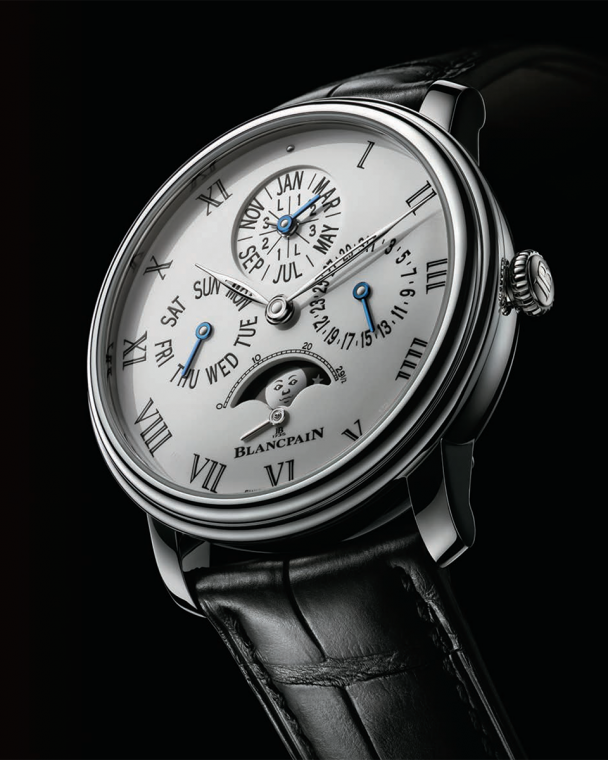
Other issues
Don't miss the latest issue
Sign Up for New Releases







